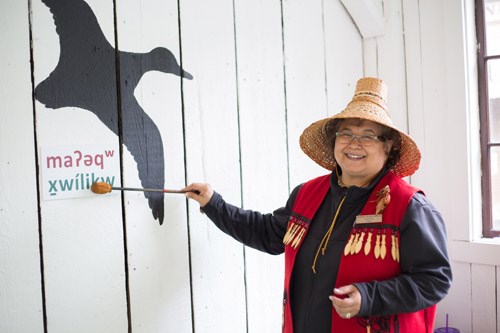There’s a space in the Burnaby Village Museum where students, teachers and the whole community can learn about the people and culture that has been in Burnaby for thousands of years.
This year, students going through the Burnaby Village Museum to learn about Christmas will also learn about local First Nations culture and celebrations with the help of four recently hired indigenous educators in a space dedicated to indigenous learning.
Museum staff have been working for two years with Burnaby school district teachers to align their school programs with the newly revised curriculum, and while the new curriculum integrates First Nations content into all areas, Sanya Pleshakov, museum programs coordinator, said their work goes deeper. It started several years ago with museum staff reaching out to local First Nations and building relationships in order to support learning about local indigenous people in and around Burnaby.
“The museum has been a place that has been silent around indigenous history in Burnaby for many, many years, and we wanted to make a conscious effort to change that,” Pleshakov said. “So, our first step was to reach out to Musqueam, Tsleil-Waututh, Squamish, Kwantlen – the local nations - so we could establish a relationship and move forward from there.”
This work is a commitment from the museum to do research into indigenous culture and “seek permission” to share it with Burnaby residents and visitors to the museum, Pleshakov said, especially important in an era of truth and reconciliation.
The museum has had knowledge keepers and cultural presenters in the past, she said, but now they have been able to hire indigenous presenters to work on school programs. Over the next few weeks, they are expecting 5,000 students for the Heritage Christmas school program and these students will have local indigenous people to teach them about culture and history from their perspective.
The indigenous educators are on site from Monday to Friday until Dec. 19 to share stories, teachings and songs about Coast Salish history and culture in Burnaby.
Meagan Innes is an Indigenous Enhancement Teacher with the Burnaby School District. She is being contracted over the holiday break as an interpreter at the Burnaby Village Museum. Innes is pleased that the Burnaby museum has taken one of the steps of reconciliation, to include indigenous history as part of the museum’s educational offering. But the thing she’s most proud of is the space that has been dedicated to indigenous learning.
The room is officially marked as a “multi-purpose room,” Pleshakov is calling it an “indigenous space,” while Innes calls it the “Indigenous Welcoming House.”
The walls are painted with at-scale silhouettes of animals that used to frequent the area before it was built up, and there are words in local First Nations languages.
The space came about through “tough discussions” and consultation, Innes said, and she’s proud of the space that was created where students can come and learn about the local First Nations.
“Because of that space being present in the museum, now that dialogue and that conversation is part of a bigger province-wide initiative to include aboriginal world view and perspective into every curricular area in our schools,” Innes said.
Innes said she has big dreams for the space, and in the future would love to see it used by a local carver where a piece of west coast art could be made that represents all communities, or as a venue for a hide tanning camp, or where drumming, music and art can be produced and traditional teachings can be taught.
“I feel that space is a really great example of how one institution wanted to follow some of our 94 calls to action through the (Truth and Reconciliation Commission) and really wanted to see, and hold an indigenous space(…) where conversations and dialogues could happen at a deeper level,” Innes said. It’s a safe place where barriers can be broken down, for professional development for teachers and for students to pick up some history that might be missing from textbooks, she added.
In addition to the added indigenous learning, at the Chinese Herbalist Shop in the Burnaby Village Museum, staff are leading children in hands-on activities and talking about the history of Chinese-Canadians in Burnaby.
For information about the Burnaby Village Museum, go to www.burnabyvillagemuseum.ca



